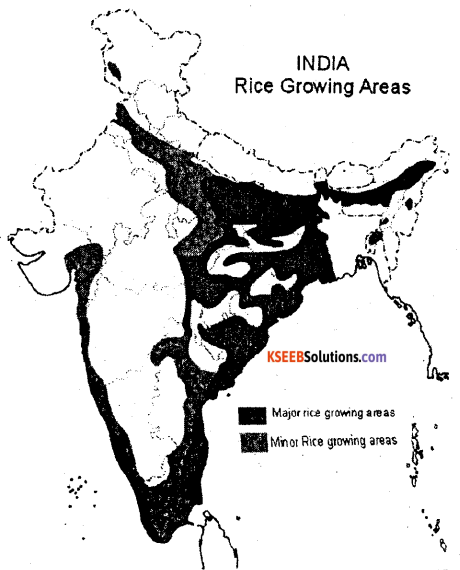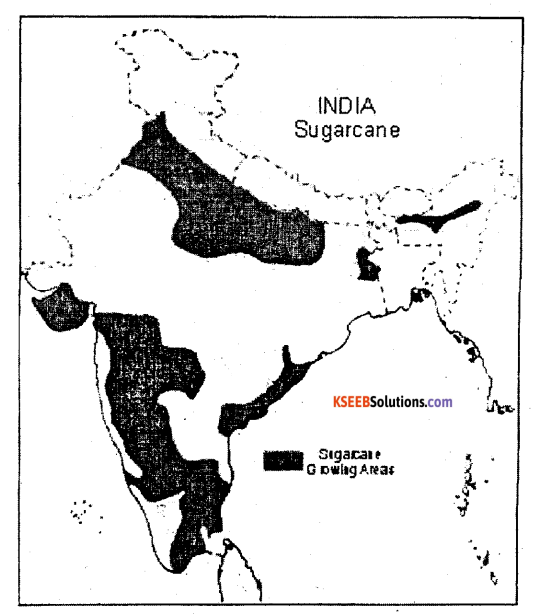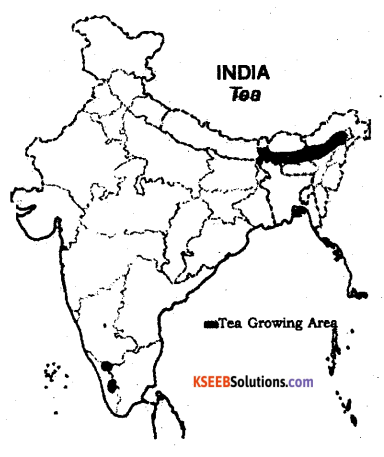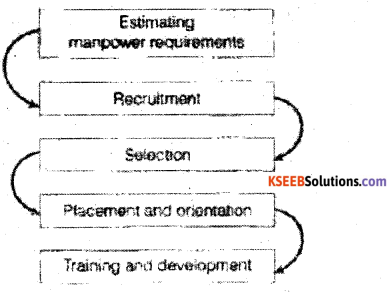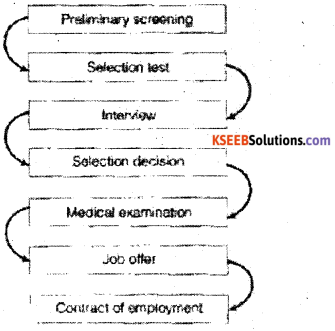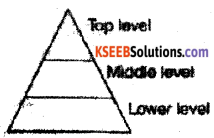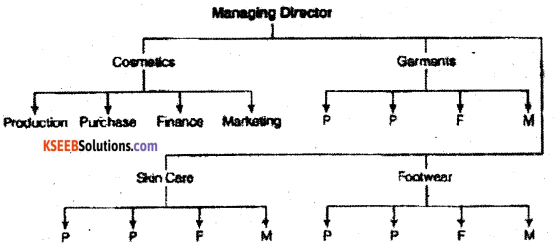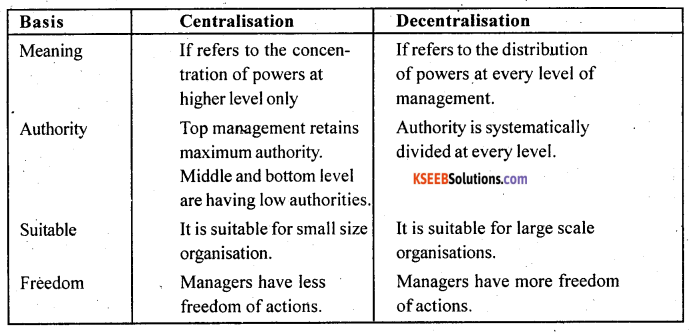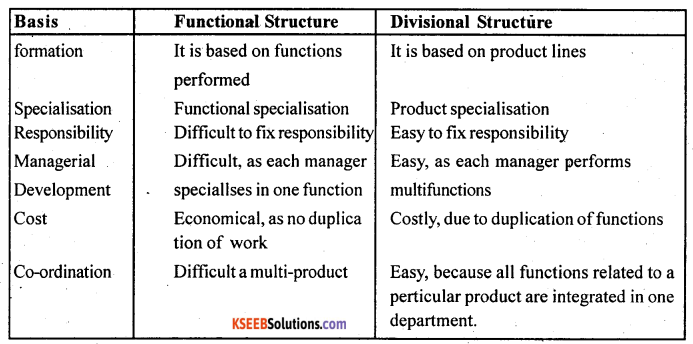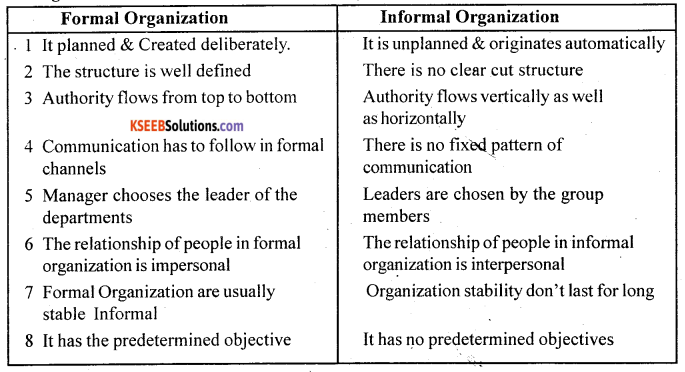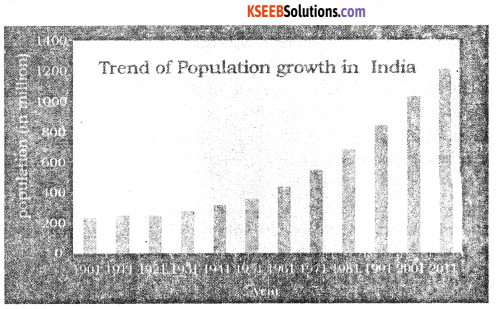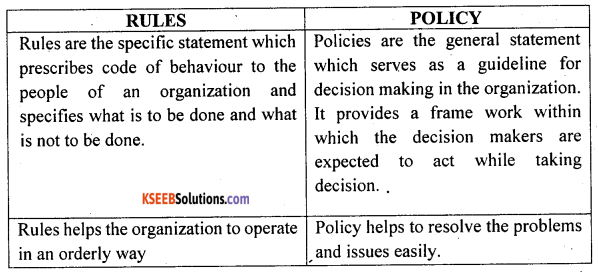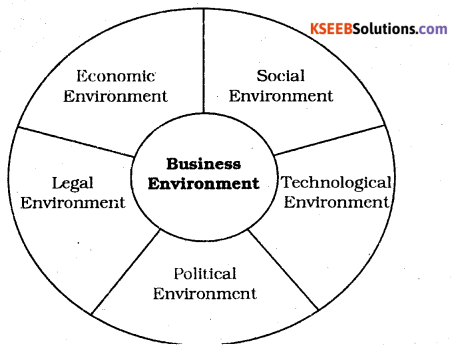You can Download Chapter 9 Mineral and Power Resources Questions and Answers, Notes, 2nd PUC Geography Question Bank with Answers Karnataka State Board Solutions help you to revise complete Syllabus and score more marks in your examinations.
Karnataka 2nd PUC Geography Question Bank Chapter 9 Mineral and Power Resources
2nd PUC Geography Mineral and Power Resources One Mark Questions with Answers
I. Answer the following in a word or a sentence each:
Question 1.
Define Mineral?
Answer:
Naturaly occuring compound with a fixed chemical composition. It is called mineral.
Question 2.
What is Ore?
Answer:
The minerals is a from which metal can be extracted are called ores.
Question 3.
What is Mining?
Answer:
The economic activity through which man is engaged in the production of minerals is called ‘mining’.
Question 4.
Which is the Beat type of Iron ore?
Answer:
Magnetite.
Question 5.
Name the metal which is made of Bauxite ore?
Answer:
Aluminium.
![]()
Question 6.
Which is called the as “Wonder metal of 20th Century” ?
Answer:
Aluminium.
Question 7.
When and where was the first Gold production was started in India?
Answer:
Kolar Gold Field [KGF] during the year 1871.
Question 8.
Which is the largest Gold producing state in India?
Answer:
Karnataka.
Question 9.
Name the Atomic minerals in India?
Answer:
- Uranium
- Thorium
- Plutonium.
Question 10.
Which mineral is called as Black Diamond?
Answer:
Coal
![]()
Question 11.
Which type of coal is the Best Quality?
Answer:
Anthracite.
Question 12.
Why Jharia is famous for?
Answer:
Jharia is “Store house of the best Metallurgical coal.
Question 13.
In which state Talcher coal mine is located?
Answer:
In Odisha.
(b) Non-conventional source of energy.
Question 14.
What are the source of energy?
Answer:
There are two types of energy:
Question 15.
What is Solar energy?
Answer:
Energy generated by sun rays through the Photovoltaic technology is called solar energy.
Question 16.
What is Biogas?
Answer:
Generation of power by using cow dung is called biogas for ex : Methane, carbon dioxide.
Question 17.
What is Geothermal energy?
Answer:
Generation of power by utilizing heat inside the earth.
Question 18.
What is Metallic minerals.
Answer:
The group of minerals which contain metal can be called as metallic minerals for ex : Iron ore. Manganese, Copper Bauxite etc.
Question 19.
What is Ferrous minerals.
Answer:
The group of minerals which contains iron can be called as ferrous minerals for ex : Iron ore, Manganese.
Question 20.
Which is the largest Iron ore producing state in India.
Answer:
Odisha. It produces 47% of total iron ore in India.
![]()
Question 21.
What is ‘Conventional Power resources’.
Answer:
The group of minerals which can’t be used again and again and also exhaustible in nature For ex: coal,-petroleum, natural gas etc.
Question 22.
Which is the best type of coal?
Answer:
Anthracite. It contains 80-90% of carbon.
Question 23.
What is the meaning of term Petroleum.
Answer:
The term “Petroleum” has been derived from two latin words, Petra means ‘rock’ and ‘oleum’ means ‘Oil’ through the word petroleum literally means rock oil.
Question 24.
Which is called ‘Liquid gold’.
Answer:
‘Petroleum’.
Question 25.
Expand ONGC?
Ans:
‘Oil and Natural Gas Commission’(ONGC).
Question 26.
What is ‘Sagar Samrat’?
Answer:
The oil taken from the depth of over 1400 meters with the help of a specially designed plat form known as “Sagar Samrat”.
Question 27.
When and where the first Oil well was drilled.
Ans:
Digboi in Assam, 1867. ’
Question 28.
What is Hydro-electricity.
Answer:
Generation of Power through the falling force of water is called Hydro-electricity.
Question 29.
Which is called ‘White coal’.
Answer:
‘Hydro-electricity’.
Question 30.
What is ‘Fossil fuels’.
Answer:
Fossil fuels are the fuels formed by natural process such as decomposition of hurried dead organisms.
Question 31.
Name the state of world’s largest Solar steam cooking system.
Answer:
Tirumala in Andhra Pradesh.
![]()
Question 32.
Which is the World’s largest Solar system.
Answer:
The Shri Sai Baba Sansthan (in Maharastra).
Question 33.
Which is the Asia’s largest wind farm cluster?
Answer:
MuppandalinTamilnadu.
Question 34.
Expand IREDA.
Answer:
Indian Renewable Energy Development Agency.
Question 35.
What are the energies of the future.
Answer:
Renewable energies such as solar energy wind energy etc. They are inexhaustible and pollution free.
2nd PUC Geography Mineral and Power Resources Two Marks Questions with Answers
Question 1.
Distinguish between Ore and Mineral?
Answer:

Question 2.
What are the main types of Minerals?
Ans:
The types of Minerals are :
- Metallic
- Non-metallic.
Question 3.
What are the uses of Minerals?
Answer:
- Minerals supports metallic industries such as iron, steel and aluminium etc.
- Many non-metallic minerals are essential for manufacturing of cement and chemical fertilizers.
![]()
Question 4.
Mention the type of coal?
Ans:
The types of coal are:
- Anthracite
- lignite
- Bituminous
- Peat.
Question 5.
Name the two important Gold producing regions of India?
Answer:
- Hutti gold field in Raichur districts and Bellary gold field in Tumkur in Karnataka.
- Ramagiri in Ananthpur district and Jonnagiri in Kumool in Andhra Pradesh.
Question 6.
In which states of India the Gondwana coal fields are located?
Answer:
The Gondwana coal field are located in Jharkhand, Odhisha, West Bengal, Chhattisgarh, Maharastra and Andhra Pradesh.
Question 7.
Mention the factors necessary for Thermal Electricity?
Answer:
- There must be Coal, Petroleum or Natural gas in abundance.
- Large space required for the construction of thermal plant.
- Abundant supply of water.
Question 8.
Biogas energy is suitable for rural India. How?
Answer:
- India is an agrarian country’ and has innumerable villages scattered all over the country.
- Animal rearing is one of the subsidary occupation of the cultivators.
- Every’ family has some domestic animals and cow dung can be used to get Biogas.
- It can be used for cooking as well as lighting of the house.
Question 9.
What are the forms of utilization of Solar energy?
Answer:
- Thermal Solar Power.
- Solar Photovoltaic
- Photo Synthesis.
![]()
Question 10.
Mention the states where the winds forms are located?
Answer:
The wind forms are located in Tamil Nadu, Gujarat, Maharashtra, Karnataka, Rajasthan, Madhya Pradesh, Andhra Pradesh, Kerala and Odisha.
Question 11.
What are the need for non-conventional sources of energy in India?
Answer:
They are capable of solving the requirements
(a) It supplies the energy in a decentralized manner and have sustainable environment. Thus the development of these power resources is very essential.
Question 12.
Distinguish between fuel mineral and non fuel minerals.
Answer:
The minerals which produces power can be called as fuel minerals for ex : coal, petroleum, natural gas etc.
The minerals that doesn’t producers power can be called as non-fuel minerals for ex : mica, limestone, graphite etc.
Question 13.
What are the uses of Bauxite.
Answer:
- Bauxite is the main source of aluminium.
- It is light weight, strong and rust resistant.
- It is used in air crafts, automobiles.
- It is mainly used in electrical industry.
![]()
Question 14.
What are the types of energy resources.
Answer:
- Commercial power resources – coal, petrol, natural gas etc.
- non-commercial power resources – fire wood, charcoal, cowdung etc.’
Question 15.
Mention the four important factors necessary for the development of Hydroelectricity.
Answer:
- The regular and uniform supply of water is essential.
- The water should fall from a sufficient height.
- It requires huge capital investment to purchase machines.
- A ready available market should be there.
Question 16.
Name the types of thermal power projects.
Answer:
- Coal based thermal power projects.
- Oil based thermal power projects.
- Gas based thermal power projects.
Question 17.
Write need for conservation of power resources.
Answer:
- Minerals are exhaustible resources.
- They occur in nature in limited quantities.
- They cannot be replaced and
- They have taken millions of years to be formed.
Question 18.
Mention the important Geothermal Centres of India.
Answer:
- Jammu and Kashmir
- Himachal Pradesh
- Uttaranchal
- Jharkhand and Chattisgarh
Question 19.
Which are the regions identified for the establishment of tidal power stations in India.
Answer:
- The gulf of Kanbhat on the West coast in Gujarats.
- Sundarbans in the west bengal on the east coast.
- Lakshadweep and Andaman nicobar islands.
2nd PUC Geography Mineral and Power Resources Five Marks Questions with Answers
Question 1.
Explain the distribution and Production of iron ore in India.
Answer:
India is endowed with fairly abundant reserves of iron ore. The estimated iron ore reserves were about 25 billion tonnes in the year 2012-2013.
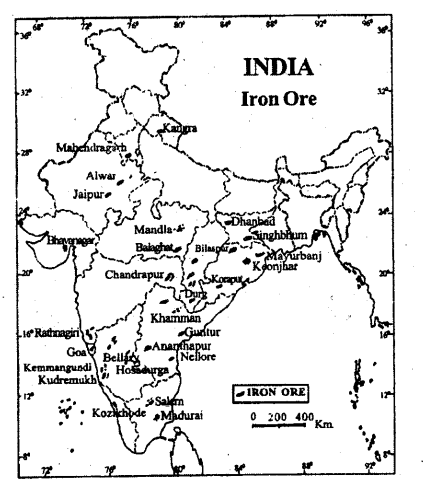
Odisha :
- It is a largest producer and accounts for about 47 percent of the total iron ore in India. Most of the deposits of iron ore in the state occur in Sundargarh, Mavurbhanj, Cuttack, Sambalapur, Keonjhar and Koraput districts,
- Chattisgarh : It produces over 21 percent of the total production of iron ore in India.
- Chattisgarh is the second largest producer of iron ore in the country. Iron ore producing areas are Bailadila in Bastar, Dhalli Rajhara in Durga and Jabalpur districts.
- Jharkhand : This state ranks third in the production of iron ore in India. It contributes nearly 13 percent of the total production areasar Budhaburu, Kotamatiburu and Rajoriburu in Singhbhum districts.
- Karnataka : Karnataka produces only 4 percent of the iron ore production in India. But it has vast deposits of Harmatite as well as magnetite iron ore in Bababudan hills in Chickmangalur district, Sandur and Hospet area of Bellary district .
- Others : In Maharashtra, Andhra Pradesh, Rajasthan, West Bengal etc produce small quantity of iron ore.
Production :
- India is the fourth largest produces of iron ore in the world.
- The total production of iron ore is 167 million tonnes in 2011 -12 and 143 million tonnes in 2012-2013.
- It is decreased by 19 percent as compared to previous year.
- This is mainly due to discontinuation of mines in Karnataka and Goa owing to the Hon’ble Supreme court.
Question 2.
Give an account of the uses, distribution and production of manganese ore in the India.
Answer:
Uses :
- Manganese is used to make steel tough and resistant to rusting.
- It is also used in the manufacture of paints, varnishes, batteries, dyes, fertilizers, pottery, calico printing, medicine.
- Manufacture of black enamel in chemical industries, bleaching powder, electrical, glass industries etc.
Thus it is known as “Jack of all Traders”.
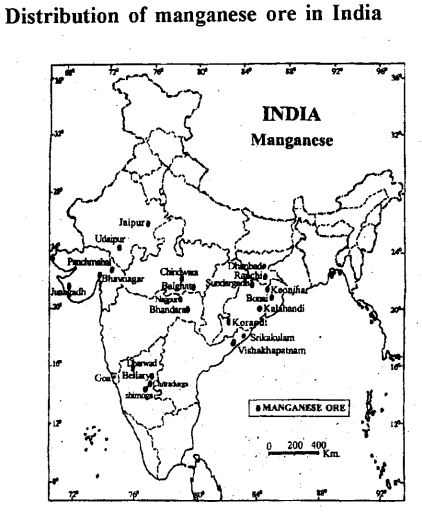
India has occupied the second place in respect of Manganese ore reserve in the world after Zimbabwe.
- Odisha : Odisha has about 40.4 percent of India’s reserves of Manganese ore. It is the largest producer and contributes over 24.1 percent of the manganese ore in htdia.
Best varieties of Manganese ore is found in Sundargarh, Kalahandi and Korput districts. - Maharashtra : It contributes about 27.7 percent of India’s manganese ore. The main manganese belt is in Nagapur and Bhandara districts.
- Madhya Pradesh : This state contributes nearly 27.6 percent of the total production of Manganese in the country.
Manganese ore are extend in Balaghat, Chindwara, Jabalpur and Dewas districts. - Karnataka : About 5.8 percent India’s Manganese ore is produced by Karnataka. The main Manganese ore deposits occur in Uttar Kannada, Shimoga, Bellary, Chitradurga and Tumkur districts.
- Andhra Pradesh : It contributes 13.8 percent of the total maganese ore production of the country. It is found in Srikakulam, Vishakapatnam, Nellore, Kumool and Cudapha dis-tricts.
- Others : Rajasthan, Gujarat, Jharkhand, West Bengal, Bihar etc are the states in which Manganese ore are distributed.
Production :
- India is the 5th largest producer of manganese ore in the world.
- Its total production was 23.22 lakh tonnes in 2010-11.
- The production of manganese is increasing from one year to another.
Question 3.
Describe the distribution, production and trade of Bauxite in India.
Answer:
Distribution :
- Bauxite ore is found in latente rocks occuring extensively either on the plateau or hill ranges of peninsular India and also in the coastal tracts of the country.
- It is estimated that total reserves of Buaxite in the country is about 2500 million tones. This reserve is the fifth largest in the vorld.
- Odisha : Odisha has large reserves and is the biggest producer of Bauxite in India. Vast reserves of Bauxite are located at Kalahandi, Koraput, Sundaragarh, Bolingir and Sambalapur districts.
- Chhatisgarh : Chhatisgarh produce more than 18.4 percent of the total production of Bauxite in the country. It is found Bilasapur, Durga, Surguja and Rajagarh districts.
- Maharashtra : Maharashtra accounts for 15.1 percent of the total production of Bauxite in the country. It mainly occurs in Ratnagìri, KoÍlapur, Jhana and Satara districts
- Jharkhand: ¡t is fourth largest producer of Bauxite in India. It contributes about 14.3 percent of total production. It is located in Ranchi, Lahardaga, Palmu and Gumla districts.
- Gujarat: Gujarat is another important producer of Bauxite in India.
It accounts for 6.6 percent in India. It is located in Jamanagar, Junagash, Kedha Kuchchh and Bhavanagar districts. ‘ - Others : East and West Godavari, Andhra Pradesh, Tamil Nadu, Kerela, Karnataka etc
Trade :
- Nearly 80 percent of the bauxite in India is used for producing aluminium.
- India’s export of bauxite have been reduced considerably due to the increasing demand in the home market.
- So, India exports only 20 percent of its Bauxite ore mainly to Italy, U.K, Japan and Germany.
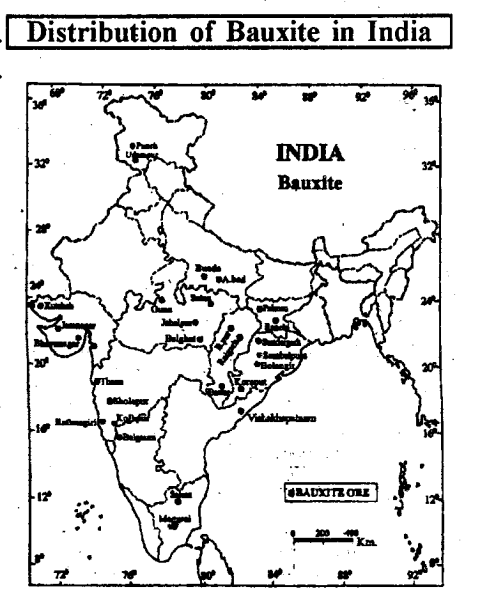
![]()
Question 4.
Explain the distribution of production of gold in India.
Answer:
Distribution :
1. Karnataka:
- It is the largest producer of Gold in India.
- The state has an estimated reserves of gold ore 17.5 million tonnes.
- It account for 17 percent of India deposits.
- It is found in Kolar, Raichur, Dharwad and Hassan districts.
- Formerly most of the gold production of the state came from Kolar Gold Field (K.G.F). The first gold mining operations took place in K.G.F. during the year 1871. The deposits in K.G.F are almost exhausted.
2. Andhra Pradpsh :
- Andhra Pradesh is the second important producer of gold in India.
- It has 7.06 million tonnes of gold deposits Gold deposits are found in Ramgiri in Ananthpur district.
- Bisanattam and Palachur in Chittor and Jonnagiri in Kumool district.
3. Jharkhand:
- Jharkhand is another producer of gold in India. Its production was about 14 kg in 2010-11.
- Alluvial gold is obtained from the sands of the Subarnarekha river and Iowa in Singhbhum district.
4. Others : Himachal Pradesh, Jammu and Kashmir, Tamil Nadu, Rajasthan etc.
Production : The total gold ore reserves are estimated that is 39.02 million tonnes in
India. But India’s share in the worlds gold production is insignificant. The production of gold has a consistent declined from 1951 to 1991.
- The gold production was 1588 kg in 2012-13 against 2710 kg of 1999-97.
- About 99 percent of the total production of gold in the country is from Karnataka.
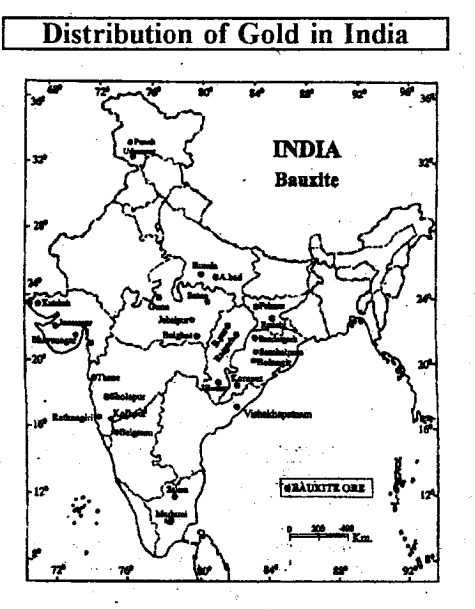
Question 5.
Discuss the importance, distribution and production of coal in India.
Answer:
Importance :
- Coal constitutes about 70 percent of the total commercial power consumed in India.
- Coal is a source of energy and raw material for many chemical industries.
- It provides many by products i.e., tar napthaline, ammonia gas, coal gas, benezol etc.
- These are used in the manufacture of synthetic fibres, rubber, plastic, explosives, dyes and insecticides.
Distribution :
- Currently the leading producer of coal in India are Jharkhand, Chhattisgarh, Odisha and
- Madhya Pradesh.
- These four states contributes 84.33 percent of the India’s coal production.
1. Chhattisgarh : It is having first place in the production of coal in India.
- It produces 31.3 percent coal of India.
- Major coal fields of the state are located in the Northern part of the state i.e, Surgija, Bilasapur and Korba.
2. Jharkhand : Jharkhand is the second largest producer of coal in India.
- It produces more than 20.3 percent of coal in 2011-2012.
- Jharia, Bokaro, Giridhi, Karnapur, Ramagarh are very important.
- Jharia is one of the oldest and richest coal fields of India. It has been recognised as the “Store house of the best metallurgical coal” in the country.
3. Odisha : It is the third largest producer of the coal and contributing 19.5 percent of the total coal production of the country .
- Most of its coal deposits in Dhenkanal, Sambalapur and Sundaragh districts.
4. Madhya Pradesh : Jharkhand is the second largest producer of coal in India.
- The main coal depoists are located in Sindhi, Shahdol, Betul, Narasingour and Chhindwara districts.
5. Andhra Pradesh :
- It produces about 9.7 percent of coal.
- It is found in Adilabad, Karimnagar, Warangal districts. ‘
6. Maharashtra : The coal deposits of the state occur in Wardha valley, Ballarpur, Warora in Chandrapur district.
7. West Bengal :
- It has 4.48 percent of the total production of the country.
- Burdwan, Bankura, Purulia, Daijeeling and Jalpaiguri are the chief coal producing districts. ’ Production : The total reserves of all grade coal in India is 283.50 billion tonnes.
- India is producing 560.90 million tonnes of coal in 2012-13.
- So India ranks third among the coal producing countries of the world next to China and
- It contributes 10.2 percent of the total world’s production of coal.
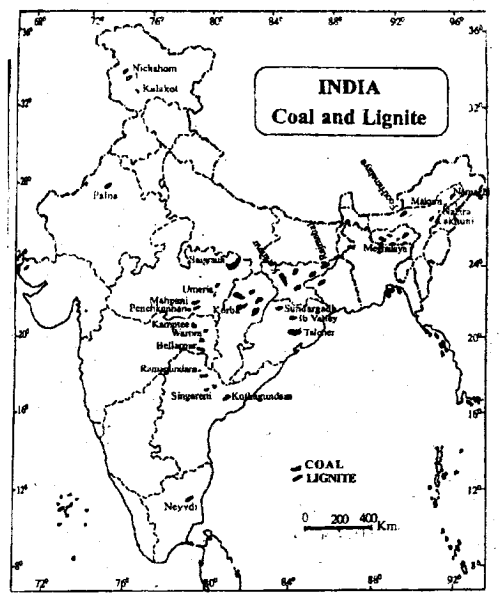
Question 6.
Explain the uses and types of coal in India.
Answer:
Uses :
- Coal is source of energy and raw material for many Chemical Industries. ‘
- It provides many by-products i.e., tar, napthaline, ammonia gas, coal gas, benezol etc.
- These are used in the manufacture of synthetic fibres, rubber, plastic, explosives, dyes and insecticides.
Types :
On the basis of its Carbon content, colour and heating intensity etc. They are as follows:
- Anthracite
- Bituminous
- Lignite
- Peat.
1. Anthracite : This is the best variety of coal. It contains 80-90 percent of Carbon.
- It is very hard, compact and black in colour.
- It produce more heat than any other form of coal.
- It ignites slowly and bums with a nice short blue flame without producing smoke.
- It is found in Jammu and Kashmir and it is mainly used for Central heating, steam in ship and boilers.
2. Bituminous:
- It contains 50-80 percent of Carbon and found in abundance.
- It is relatively hard and black in colour.
- Mainly it is used in steel industry and thermal power generation.
3. Lignite:
- It is low grade Variety of coal.
- It contains only 40-55 percent of Carbon.
- Its colour is dark to black brown.
- It will give more ash and moisture generation of thermal power, fertilizers and gas.
4. Peat:
- It contains less than 40 percent of Carbon. Therefore it is inferior in quality.
- It gives less heat, but releases more smoke, and a lot of ash after burning.
- So it is mainly used in the thermal power plants and fertilizer industries.
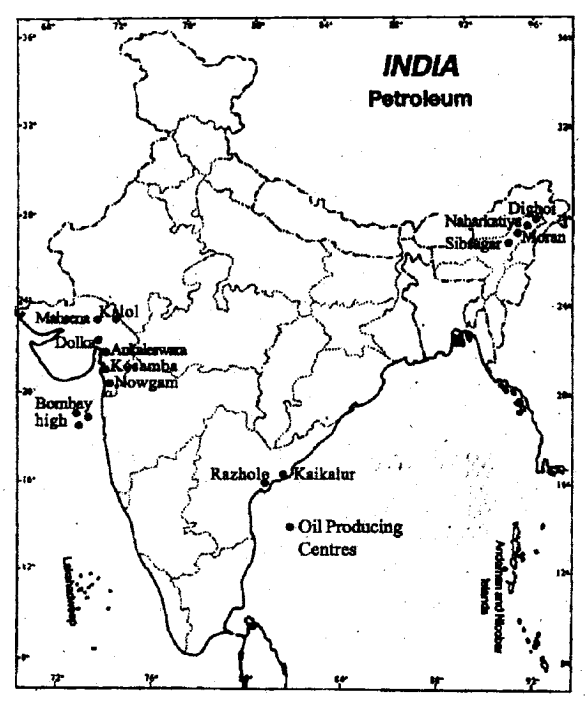
![]()
Question 7.
Describe the Occurance, Production and Distribution of crude oil in India.
Answer:
Occurance :
- In India petroleum .was discovered in I860.
- Another important achievement was the discover of oil in the Digboi area in 1889.
- The government of India contituted a separate Directorate of Oil and Natural Gas Commission (ONGC) on August 1956, Oil India Ltd., (OIL) on Febraurv 1959.
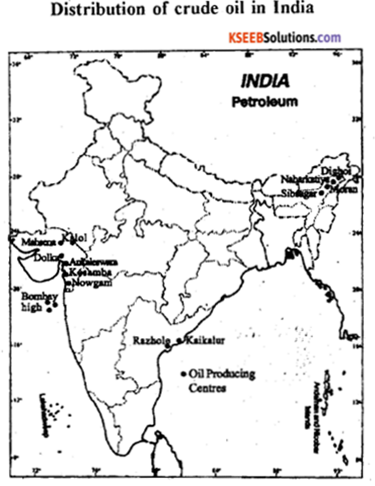
1. Bombay High: This is the largest oil producing area contributing 42.7 percent of the total crude oil output of the country.
- It is found in coat of Maharashtra about 176 km of the North-West Mumbai.
- It is known as “Sagar Samrat”.
2. Assam :
- In India the petroleum was first dicovered at Makum (Assam) in 1867. The first oil well was drilled at Digboi.
- It contributes about 13.2% of the oil production in the country. ‘
- Major oil fields of Assam state are the Digboi, Naharkatiya, Rudrasagar, Sibsagar and Hugrini.
3. Gujarat: It contributes 15.2% of Petroleum production in India.
Ankaleshwar and Cambay are the main oil fields, Kolob, Nangaon etc.
4. The Eastern Coast Oil field : The basin and deltas of the Godavari, the Krishna of Andhra Pradesh and the Cauvery river of Tamil Nadu holds great potential of oil and natural gas production.
5. Others : Uttar Pradesh, Punjab, Rajasthan etc Production :
- The total production of Petroleum in India was 380.9 lakh tonnes in 2011-12.
- India is not a significant producer of Petroleum in the world.
- Recently the domestic crude oil production has increased. This is because of the constant efforts made by ONGC and Oil India Ltd.
Question 8.
Give account of Thermal and Nuclear Energy of India.
Answer:
Nuclear Energy :
- The energy generated from the fission of the atomic minerals such as Uranium, Thorium,
Plutonium is called ‘Nuclear Energy’. It has played an important role in the power development of India. - The demand for energy has been increased with the increase of population in the country.
- The country has power crises as the production is insufficient to meet the requirement.
- To meet energy needs of the country nuclear power programme was formulated.
- The first nuclear power plant was started in 1969 at Tarapur near Mumbai with U.S.A assistance. Now there are 7 nuclear power stations in India.
Thermal Energy :
- The Energy generated by using fossil fuels like Coal, Petroleum and Natural gas is called thermal energy. It can be produced even from Nuclear fission and wood.
- It has certain advantages as against hydro-electricity. The initial capital involved in the construction of thermal plant is low and time requirement is short.
- The disavantages of thermal electricity are low efficiency in terms of heating value and higher operation cost.
Question 9.
Describe the Non-Conventional Energy resources in India.
Answer:
The Power resources other than the traditional fossil and Mineral sources are known as ‘Non Conventional Power Resources’. They include Solar energy, Wind energy, Bio-gas, Sea waves, Biomass and geo-thermal etc. These reasources are inexhaustible and renewable in nature.
Importance :
- These Power resources are found in abudance, pollution free, eco-friendly and not harm to the eco-system.
- They can be very conveniently supplied to urban as well as rural areas.
- In India conventional power resources are inadequate. Recently the rate of energy consumption has been increased.
- Hence there is urgent need to harness other alternative power resources.
- Top priority has been given for the development of non-conventional power resources.
- They are capable of solving the requirements. Such as supply of energy in decentralized manner and have sustainable environment.
- Thus the development of the these power resources is very essential.
Question 10.
Explain the Conservation and Management of Mineral and power resources.
Answer:
Meaning :
- In General “Conservation” refers to the protection and preservation of natural resources and the natural environment for the future.
- This also includes the careful management of natural resources such as minerals, power resources, soil, forests etc., to prevent their destruction or over exploitation.
- The process of managing controlling or conducting is called ‘management’.
Need for Conservation :
- Minerals are exhaustible resources. They occur in nature in limited quantities.
- They cannot be replaced. They have taken millions of years to be formed.
- Human needs have increased greatly and minerals have been exploited without thinking of the Consequences.
- The present day energy, which runs our industries mostly comes from minerals.
- Hence it is necessary that we have to conserve and manage our minerals and power resources.
![]()
Question 11.
Explain the production and distribution of natural gas in India.
Answer:
Natural gas is supposed to be the fuel of the 21st Century, because of its efficiency and clean,
Giogrcupbu) (U PUC)
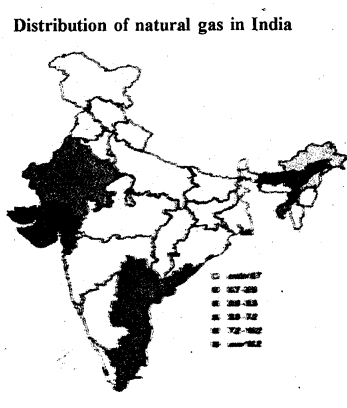
- It is estimated that reserves of natural gas were 1330.26 billion cubic meters (BCM) India produces nearly 47 BCM annually.
- Bombay High : The Bombay high occupies the first place both in terms of reserves and the production of natural gas in India. It accounts for about 81 percent of the total gas production of the country.
- Gujarat and Assam are occupies second and third place respectively Khambhat in Gujarat and Khavaght in Assam are the major producers.
- It is also found in Mangalam in Tamilnadu, Linglu Andhra Pradesh and Jaisalmer in Rajasthan etc.
Production: India produced 47.9 billion cubic meters (bcm)ofnaturalgasin2011-12. In the recent years the production is increased with the increasing of demand. - The efforts have been made by the Government of India to improve the production.
- There is a big gap between demand and indigenous production of natural gas. This has to be met through imports.
- ONGC and OIL has taken measures to increase the natural gas production.
Question 12.
Describe the important nuclear power plants in India.
Answer:
There are 7 nuclear power stations in India they are –
- The first nuclear power plant was started in 1969 at Tarapur near Mumbai with USA assistance. It has installed capacity of 1400 MW.
- Ranapratap sagar plant near Kota in Rajasthan. It was established in 1973. Its capacity is 1180 MW.
- Kalpakkam nuclear plant near Chennai in Tamilnadu was established in 1984 and its capacity is 440 MW.
- Narora nuclear plant near Narora in Uttar Pradesh was established in 1991 and its capacity is 440 MW.
- Kakrapara Atomic power plant near Kakrapur in Gujarat. It was established in 1993 and its capacity is 440 MW.
- Kaiga nuclear plant at Kaiga near Karwar in Karnataka. It was established in 2000-and its capacity is 660 MW.
- Kundakulam in Tamilnadu which was very recently commissioned in 2013. Its capacity is 1000 MW
There is a proposal to set up new nuclear power plants at Sri Sailam in Andhra Pradesh, Jaipur in Rajasthan, Tuticom in Tamilnadu, Talchar in Odhisha and Kolkata in West Bengal.
Question 13.
Explain the measures to conserve the mineral and power resources in India.
Answer:
The following measures may be adopted to conserve mineral and power resources :
- Exploitation of new minerals : It should be explored in accessible areas like high moun-tains, ocean beds and polar regions.
- Conservation of minerals during mining : Conservation of minerals during mining such as coal and natural gas gets damaged and lost due to fire. This destruction has to be stopped.
- Maximum extraction of mined minerals : New technologies should be developed to obtain maximum metal and by products from ores.
- Multipurpose use to minerals : In order to gain maximum utility of the minerals.
- Safe godowns : After mining minerals should be stored properly to avoid the conditions which adversely affect their properties.
- Exploration of alternatives for minerals : It is essential to explore substitutes of minerals found in limited quantities.
- Re-use of minerals : It is another way through which mineral resources can be conserved. ’
- Use of power resources as raw materials : Power resources should not only be a source of power, rather they should be used in industries as raw materials.
- Prohibition of pollution: Mining activity have brought about many effect therfore it must be reduced.
- Developing alternative fuel sources of energy and use more renewable energy sources.
![]()
